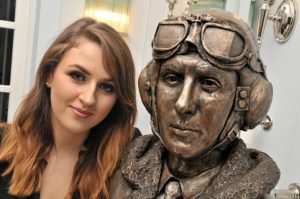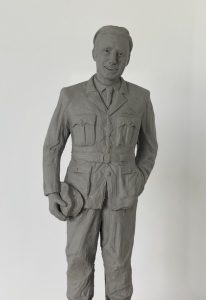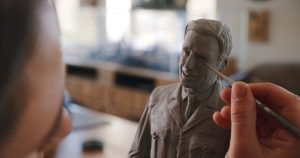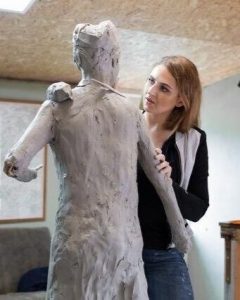An Interview with Billy Fiske Sculptor Jenna Gearing

Jenna with Captain Eric Winkle Brown
Your work on the Billy Fiske sculpture is exciting and revealing. Please tell us a little about your background and some of your thought processes in your approach to tackling this project?
I got into bronze sculpting for the love of immortalising not only someone anatomically but also to capture someones personality in an otherwise lifeless material. The excitement only grows for me when I have the challenge of sculpting someone as prestigious as Billy Fiske.
My first public commission was that of Captain Eric Winkle Brown for the Fleet Air Arm museum when I was aged 20 and I have been fortunate to been given some wonderful commissions in the years since. When I first heard about the Billy Fiske project and my chance to sculpt it I felt so incredibly honoured.
Billy represents not only a true, selfless and achieved hero but also emphasises the incredible link our two nations have in terms of friendship and willingness to support each other through even the toughest times.
 Was there research into the life of Billy Fiske? That is, does his accomplishments and sacrifices play into the creative process?
Was there research into the life of Billy Fiske? That is, does his accomplishments and sacrifices play into the creative process?
Being someone who was alive decades ago, there are only a finite amount of photographs available of him. This proves a challenge in the creative process as there is only limited “information” I can collect as an artist on his features.
For someone as accomplished as Billy, to fit in so much in his mere 29 years, it had to be decided which achievement the Billy Fiske foundation wanted to represent most in this sculpture. Would it be the Olympic achievement, the educational achievement or the incredible War Efforts.
This decision determines his outfit or uniform, his stance and his facial expression.
How does this project differ, if at all, from other sculptures of historic figures?
Unlike many figures who have been sculpted in bronze in the current news cycle, Billy Fiske does not have a tarnished history, fighting for fundamental rights of freedom and liberty against abhorrent ideas of fascism and nazism. He is the definition of a true selfless, loyal and committed hero, even denying a chance to compete in the 1936 Berlin winter olympics in a staunch protest of Hitler.
I was told in art school, “there’s often a stage in any creative project when you hate it. You must resist the urge to tear it up and start over. Just keep working and you’ll eventually like what you see.” Do you ever have that feeling?
Through my years of sculpting I have definitely learned patience and when to step away. I do entirely relate to this notion and do remember times when I was younger where I would get frustrated and end up causing more harm than good.
Sculpting is an incredibly involved process and you do develop attachments. In recent years I have learned that when these feelings come it is best to take yourself away, go for a walk or a ride and and approach it with a new mindset.
 If you could say a few words at the statue dedication that you would hoped to be remembered, what would they be?
If you could say a few words at the statue dedication that you would hoped to be remembered, what would they be?
Billy Fiske paid the ultimate sacrifice for his beliefs and truly exemplifies the Special Relationship between the US and the UK. Despite hardships physically unimaginable to many people of modern society, he showed stoicism and the upmost resolve to stand firm.
This firmness crossed international boundaries, even taking up the colours of another country to protect people he would never meet from unimaginable horrors, with no heroism in his motives. That is why I feel so honoured to have been able to engage in this project to immortalise in bronze a man who died not much older than I am today, and to provide a constant reminder to onlookers to this mans amazing attitude.
With everything going on during this pandemic, how have you kept yourself positive? Is sculpting serving to be even more than a career to help enjoy the moments we can?
I am so incredibly blessed to be able to call my passion in sculpting my career. I get an unimaginable amount of enjoyment out of it. Of course like any artistic career I do face my challenges when things don’t go to plan but I have learnt so much patience from it and to sometimes take a step back and approach it with fresh eyes and a fresh attitude and the satisfaction when it all finally comes together is so very rewarding.
What part of sculpting has been your favorite during the process and preparation of the Billy Fiske statue? What are you most proud of? What do you enjoy perfecting?
I came to sculpting with a love of creating the human form and the challenges it possessed in getting it right. It is not only about creating a likeness for me but also to capture personality and vitality. Billy was not often seen not smiling; and what a smile that was! I thoroughly enjoyed researching about him and digging up photos that could help me in my process.
Where are we on the statue at present?
The process firstly involved creating a table top size “maquette” which is about 1/6th life-size. When making a sculpture this small it is incredibly fiddly but provides a useful method to be able to make adjustments and changes much easier to rectify on this small scale than would be on the actual large scale sculpture of him.
This maquette is completed and will soon be destined for the foundry where it will be moulded and cast in bronze as a limited edition run of 12 and will be available to purchase to further fundraise for the Billy Fiske Foundation.
What are you working on today?
Today I have my hands in clay making a private commission of a thoroughbred racehorse. When I’m not making portraiture I absolutely love creating sculptures of wildlife and animals and it is so wonderful to be able to have multiple sculptures on the go to keep things fresh and exciting.
Ms. Kate Billings contributed to this article.

Gearing at work
Artist Statement
As a young artist, I strive to bring vitality and a sense of freshness into each piece. I do this by combining traditional pattinas with sculptures filled with life and presence. In this manner I consciously strive to capture a moment, gesture or feeling that is immediately relatable.
My sculptures are figurative and are mostly created on commission. My focus is animals and humans, with portraits being my most challenging yet rewarding pieces.
When sculpting my art I consider the three most important processes to be capturing, interpreting and representing.
Working with clay allows me to convey the character and emotion of a subject and I continuously aim to ensure my pieces are instantly recognisable.
The subject, either through live sittings or photographs, is personally interpreted in a way that I think will be most beautifully and accurately portrayed in the final bronze piece. This of course leads me into the ultimate stage and one of utmost importance: representation. Through my sculpture I hope to captivate and engage the viewer by allowing them to relate to the realism and personal nature that my finished pieces project.
At eleven years old I first started using clay in ceramics lessons at St Leonards Mayfield school. We were taught how to make small pots, animals and vessels. In time, I began becoming more experimental as my confidence with the material grew, creating more intricate and larger pieces.
This soon resulted in getting pieces cast in bronze, before holding my first private exhibition in 2012.
Over the last few years I have enjoyed nothing more than creating human and animal sculptures, and have loved finding out about their stories. My love for nature has allowed me to particularly focus on wildlife and domestic animal pieces, as well as specialising in war veterans.
I continue to work on both private and open commissions, whether that be for museums or personal requests.
https://www.jennagearing.co.uk/




